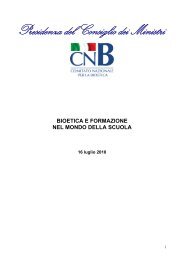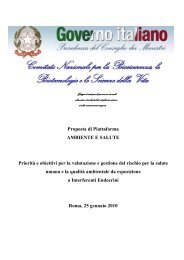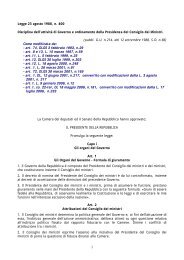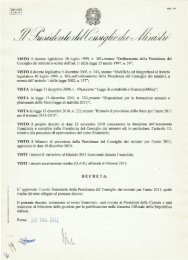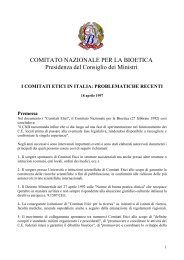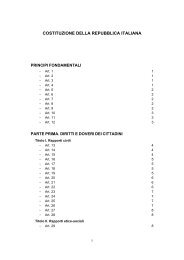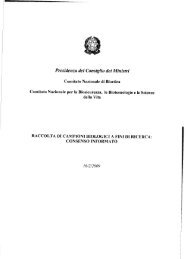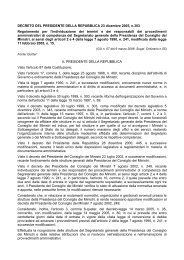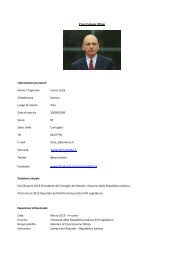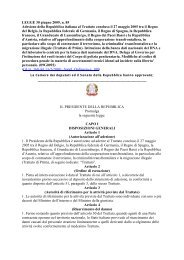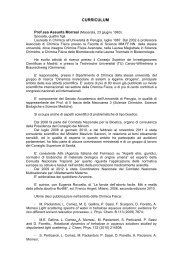President
President
President
You also want an ePaper? Increase the reach of your titles
YUMPU automatically turns print PDFs into web optimized ePapers that Google loves.
with regards to its practical applicability (no patent has even been refused on<br />
the basis of this clause), and with regards to its general meaning 88 .<br />
It must therefore be taken into account that the concept of public order<br />
and morality implies a complete overhaul of the widespread feeling of the<br />
international community, a feeling that goes beyond the directives of a single<br />
country, as recalled by the Guidelines on biotechnological inventions, which<br />
suggest that “a fair test to apply is to consider whether it is probable that the<br />
public in general would regard the invention as so abhorrent that the grant of<br />
patent rights would be inconceivable” (EU Dir. 98/44/EC.). A trend for the<br />
application of the “ethical clause” can be found in Article 6 second subsection,<br />
which exemplifies a non-exhaustive list of non-patentable inventions: “a)<br />
processes for cloning human beings; b) processes for modifying the germ line<br />
genetic identity of human beings; c) uses of human embryos for industrial or<br />
commercial purposes; d) processes for modifying the genetic identity of animals<br />
which are likely to cause them suffering without any substantial medical benefit<br />
to man or animal, and also animals resulting from such processes”. Also Article<br />
27, paragraph 2, of the Agreement on Trade Related Aspects of Intellectual<br />
Property Rights (TRIPS 2) authorises individual countries to exclude the<br />
patentability of inventions that are in contrast with “order public or morality,<br />
including to protect human, animal or plant life or health or to avoid serious<br />
prejudice to the environment, provided that such exclusion is not made merely<br />
because the exploitation is prohibited by their law”.<br />
Chimeras and hybrids are not openly mentioned, but “Consideration”<br />
number 38 of the EC Directive, clarifying the scope of Article 6, explicitly states<br />
that the list has a merely indicative character for the purpose of interpreting the<br />
reference to public order or morality and significantly adds that “whereas<br />
processes, the use of which offend against human dignity, such as processes<br />
to produce chimeras from germ cells or totipotent cells of humans and animals,<br />
are obviously also excluded from patentability”. This principle is stresses by the<br />
Guidelines for Examination in the European Patent Office (December 2007):<br />
“Also excluded from patentability under Art. 53(a) are processes to produce<br />
chimeras from germ cells or totipotent cells of humans and animals (EU Dir.<br />
98/44/EC, rec. 38)”.<br />
We could conclude that the creation of chimeras and hybrids is contrary,<br />
beyond the cloning techniques adopted and the embryo’s legal status, to the<br />
general clause of respect for ordre public and morality. However, in the<br />
interpretative processes, the boundary between biological sequences easily<br />
assimilated to any chemical reaction and human biological sequences which<br />
imply protection of dignity profiles, is still uncertain, as recalled in the<br />
Commission Report to the European Council and Parliament on the<br />
“Developments and implication of patenting laws in the biotechnology sector”<br />
(COM/2005-312). Generally, there’s no lack of interpretations that assimilate<br />
chimeras and hybrids, obtained with any genetic material, to mere “interspecies<br />
entity” biological artefacts or “Human/Non-human Interspecifics”. An<br />
Australian society, Amrad, in 1999 obtained a patent that covered the<br />
production of embryos containing human cells and cat, sheep, pig, bovine, goat<br />
or fish cells 89 . Edinburgh university had originally obtained a patent (EP number<br />
88 D. Neri, Etica e brevetti: il caso delle cellule staminali umane, “Bioetica”, 2008, 2, pp. 203 ff.<br />
89 Subsequently, a provider of some of the base materials in the Chinese technological<br />
development was sold to an American society, Chimicon international.<br />
www.newsmax.com/archives/2003/8/153903.shtml<br />
45




